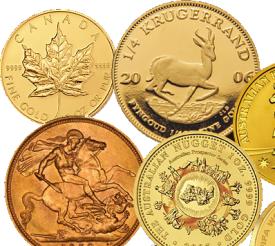What You Should Know About World Gold Coins
Understanding world gold coins can be both a fascinating and confusing subject. Knowing the difference between gold bullion coins and numismatic coins can help clear things up.
In ancient times gold coins were used as currency and were a symbol of wealth and prestige whereas gold coins today are seen more as an investment vehicle. Having a look at present day gold coins compared to historic coins will, I hope help eliminate some of the confusion as well. It is thought that the first pure gold coins were produced around 560 B.C although some believe the first gold coins may be traced back to 700 B.C. and were made of a blend of silver and gold called ‘Electrum’.
World Bullion Gold Coins Versus Numismatic Coins
 Today most gold coins throughout the world that are currently being manufactured are either gold bullion coins (more for investment) or gold collectible (numismatic) coins. Bullion coins usually minted on a yearly basis. Many bullion coins have what are termed as “proof” counterparts, which are the more meticulously manufactured and aesthetically pleasing versions of the bullion coins. These “proof” versions of gold bullion coins are a type of collectible coins that are issued in the same year as their bullion counterparts. On the other hand, some collectible gold coins (such as commemorative coins) are manufactured only in very limited quantities and some are minted during only a single year.
Today most gold coins throughout the world that are currently being manufactured are either gold bullion coins (more for investment) or gold collectible (numismatic) coins. Bullion coins usually minted on a yearly basis. Many bullion coins have what are termed as “proof” counterparts, which are the more meticulously manufactured and aesthetically pleasing versions of the bullion coins. These “proof” versions of gold bullion coins are a type of collectible coins that are issued in the same year as their bullion counterparts. On the other hand, some collectible gold coins (such as commemorative coins) are manufactured only in very limited quantities and some are minted during only a single year.
Bullion gold coins of the world have a set of common characteristics that facilitate their trade-ability among investors worldwide. All these bullion coins are mass produced and are not rare unlike their corresponding proof versions and other collectible gold coins; their respective values depend upon the amount of pure gold metal that they contain; their composition and physical dimensions (sizes and weights) are precisely defined by national laws; they are not intended for general circulation (although some have nominally low face values and are legal tender in their particular country of origin); and, their gold contents are stated in standard units of mass (usually in troy ounces, grams, and kilograms).
Collectible Or Numismatic Gold Coins
The main difference between collectible or numismatic gold coins and bullion coins is that value of bullion coins is determined largely by the price of gold on any given day whereas numismatic coins derive their value in a small part from the price of gold but to a larger extent by their perceived collectibility or intrinsic value. To explore the difference between bullion and numismatic coins in depth I suggest you read our post on how to buy gold coins.
Modern Day Gold Coins
Austrian Corona
The Austrian 100 Corona can be considered as the first of the modern gold bullion coins (bullion coins that were minted at the beginning of the 20th century, onwards). This bullion coin has a 0.9803-troy-ounce fine gold content. It was first minted in 1908 and its association with the Hapsburg nobility helped contribute to its early popularity. This gold bullion coin is no longer minted but it is still available in the world gold coin market.
Mexican Peso
The Mexican 50 Pesos (“Centenario”) coin was issued to commemorate the 100th-year anniversary of Mexican Independence. This gold bullion coin features an “angel of freedom” image on the obverse and an eagle with a snake in its beak on the reverse. This bullion coin contains 1.2057 ounces of pure gold and was first minted in 1921. By 1948, the popularity of this coin tended to increase the premiums charged on top of the actual value of the gold; and to counter this trend, the Mexican national mint issued some yearly batches of this coin with a single date – 1947. “Restrikes” is the term used to refer to coins marked with the same date but minted in different years.
South African Krugerrand
The first gold coin that was issued primarily for investment purposes and that contains exactly one troy ounce of gold is the Krugerrand. This bullion coin was issued in 1967 by the South African government; and from the year it first came out until 1979, it was the only troy-ounce-denominated gold bullion coin that was available to international investors. The Krugerrand has a fine gold content of 91.67%.
Other Gold Coins Of The World
Other national governments recognized the benefits of having a national gold bullion coin and followed suit with their own respective issues. Canada offered the Maple Leaf for the first time in 1979, Mexico ended production of the Centenario and issued the Libertad starting in 1981, China issued the Panda in 1982, the United States, the American Eagle in 1986, the United Kingdom, the Britannia in 1987, Australia, the Kangaroo in 1987, Austria, the Vienna Philharmonic in 1989, and Malaysia, the Kijang Emas in 2001.
Most national-mint-issued gold bullion coins have their fine gold contents measured by weight in troy ounces, usually in four fixed “sizes”: 1, ½, ¼ & 1/10 ounce. There are also 1/20 oz coins, as well as 1 kg and 10 kg coins. The most common is the 1 troy ounce gold bullion coin, comprising about 80% of world gold bullion coins (troy-ounce denominated).
About 250 million individual pieces of gold bullion coins have been produced since 1970 (with a combined gold-content weight totaling to about 3,500 tons). In some territories (such as in EU member countries, although the UK charges capital gains on imported bullion coins), gold bullion coins are exempted from import duties and sales taxes; but in others (e.g., Australia, Canada, Japan, Russia, the USA, etc.), these exemptions are unavailable. Australia, for example, charges a goods-and-services tax (GST) on sales of gold coins and gold bars with fine gold contents of less than 99.9%. Note that if the transfer of ownership of a legal tender gold bullion coin takes place within that coin’s country of origin, that transfer is not taxable.
Interesting Facts About Gold Coins
Gold coins were probably first issued as money in ancient Greece (Lydia in particular) by decree of King Croesus. The Persians had the Daric, the Romans, the Aureus and the Solidus, the Arabs, the Dinar, the Chinese, the Ying Yuan, and so on.
The most popular gold bullion coin today in terms of quantity sold (about 60 million pieces since 1970) is still the Krugerrand. The popularity of other gold bullion coins vary by country, but maybe the Canadian Maple Leaf comes after the Krugerrand in terms of worldwide popularity. The Vienna Philharmonic is probably the most popular in the EU zone. In terms of total weight in gold issued as gold bullion coins (about 840 tons) since 1970, South Africa still leads the pack.
World’s Largest Gold Coin
The world’s largest gold coin minted in Australia in 2011, it is the 1 tonne Australian gold coin and as it’s name will tell you contains 1 tonne of .999 fine gold. This is equivalent to 1000 kilograms or 32,150 troy ounces, at today’s spot price of $1,560.00 US that works out to $50,025,400.00 of actual gold content not to mention the workmanship and intrinsic value.
The 1 tonne gold Kangaroo is often referred to as the jewel of the coin world. It is on permanent display in the Perth Mint where it was made.
Still To Come
In the coming weeks we will continue to explore world gold coins from Turkey to Canada, come back and learn more about the world of gold coins.









